There are many patterns for knitting from leftover yarn that allow you to use the accumulated balls and create an interesting, original and useful thing.
Features of knitting with different threads
Over time, needlewomen collect leftover yarn of different textures, thicknesses and colors. Based on the available variety, you need to think about how best to combine the yarn. In some products, you can combine cotton and acrylic, mohair and melange, in others, it is better to select threads of the same texture.
The thickness of the yarn can also be combined, alternating thick and thin threads, or the middle part of the product can be knitted with yarn of one thickness, and the edges with another.
The knitting pattern can be changed along with the thickness of the thread. If you need to get yarn of one thickness, then thinner threads are taken in 2-3 additions. The number of knitting needles or hook is selected according to the thickness.
The items are knitted in one piece or in separate fragments that are then joined together. If yarn with knots and bobbles is used, it is better to knit with stocking or garter stitch and not to use patterns.
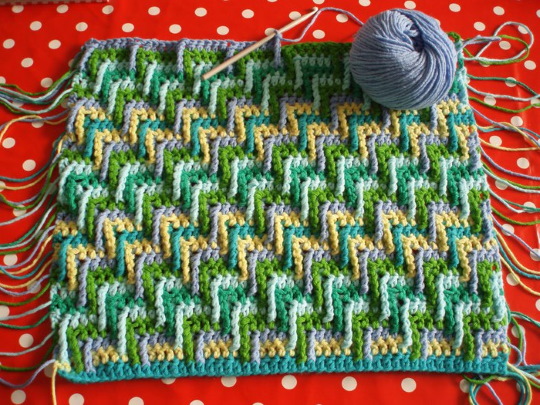
You can also experiment with color by knitting individual pattern fragments or product parts with yarn of different shades. Contrasting colors look more impressive in the finished product. To prevent the product from being too colorful, you can choose a base color and 2-3 shades of yarn remnants.
Preparing the balls
When preparing yarn, you need to not only decide on the thickness and color scheme, but also pay attention to the structure of the threads. If a used product has unraveled, the yarn will be wavy. Knitting from such material is not very convenient, and as a result, an uneven fabric may be obtained.

To straighten the yarn, it needs to be steamed (heat water and hold the yarn over the steam) or washed and dried. Before processing, the yarn is unwound, using, for example, the legs of a stool, and then wound back into balls.
A "folk" way of steaming yarn: place the ball in a container, pull the thread through the inverted lid of a pot of boiling water. Slowly wind the thread into a ball.
Interesting ideas, patterns, what to knit for the home with crochet and knitting needles from the remains of yarn
Knitting patterns for any product from leftover yarn allows you to use your imagination and creativity to create original items.
This:
- home products: pillows, rugs, covers, blankets, panels;
- small kitchen items: hot pads, potholders, napkins, tablecloths;
- souvenirs: toys, baskets, pencil holders, bookmarks;
- clothes and jewelry.
The following notations are used in the circuit descriptions:
| Hook | |
| PP | lifting loop |
| VP | air loop |
| st.b/n | single crochet |
| st.s/n | double crochet |
| st.s/2n | double crochet |
| Spokes | |
| LP | facial |
| IP | purl |
| nak. | yarn over |
The description enclosed in ** is repeated.
Rugs
The simplest product made from yarn scraps is a rug. It can be knitted into a single piece of any shape: rectangular, square, round, or assembled from several identical fragments, which are then connected with a needle or crochet hook. Multi-colored fragments can be square, triangular, or diamond-shaped, knitted with a simple pattern, such as garter stitch.
Bath mat
Crochet multi-colored squares from semi-woolen yarn. Cast on the desired number of VP chains and 2 PP. Knit alternately a row of sc and a row of elongated loops.
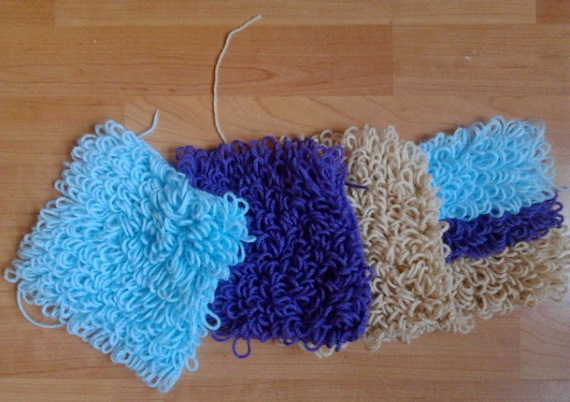
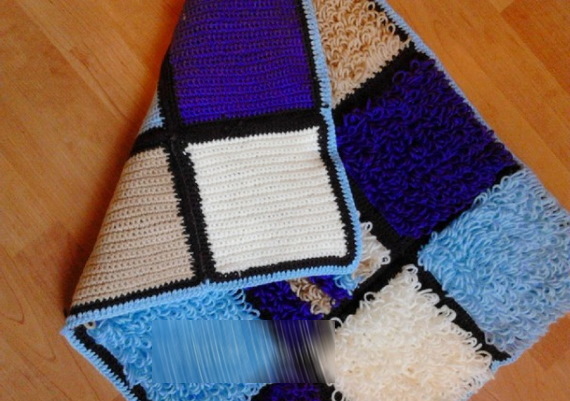
Each of the squares is tied with 2 rows of sc and combined into one piece. You can tie the entire rug. For tying: 3 VP, 2 dc in one loop and a slip stitch in the third loop of the previous row.
Simple rectangular rug
From the remaining yarn, selected by thickness, from VP knit chains, which are connected as you knit or sewn and wound into balls. The rug is knitted with face loops on thick knitting needles. After finishing the work, crochet the resulting product.
How to Make Rugs Non-Slip
Knitted rugs can be placed in any room, on the balcony and near a pet. They help create coziness and serve for a long time. The disadvantage of knitted rugs is that they slide on the floor.
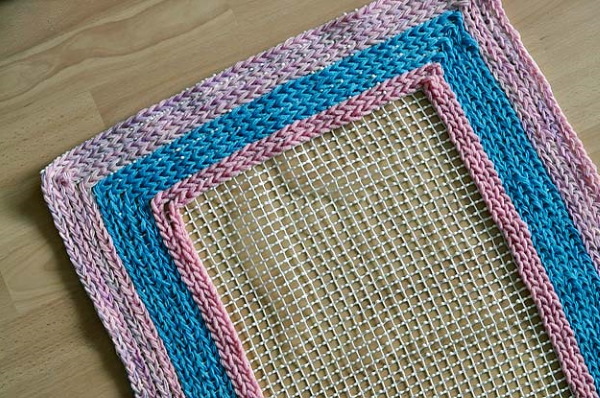
To eliminate this quality, you can purchase a special rubberized anti-slip mesh. It is cut to a size slightly smaller than the rug, and is not glued. In this case, the rug is washed separately from the base. You can also crochet directly on the base, pulling the thread through the holes. Then you will have to wash the product together with the base.
Blankets
Knitting a blanket pattern from leftover yarn will not be difficult, since a variety of patterns are suitable for the blanket: squares, zigzags, satin stitch, braids. An original patchwork blanket in the patchwork style will turn out if you crochet or knit colored squares and connect or knit them into a single piece.
Blanket in squares
Description of the pattern for knitting a square with a side of 16 loops:
- Cast on 33 stitches (16 + 1 + 16).
- All loops are knit.
- In the 2nd row and subsequent ones, knit 1 LP from the 3 central loops.
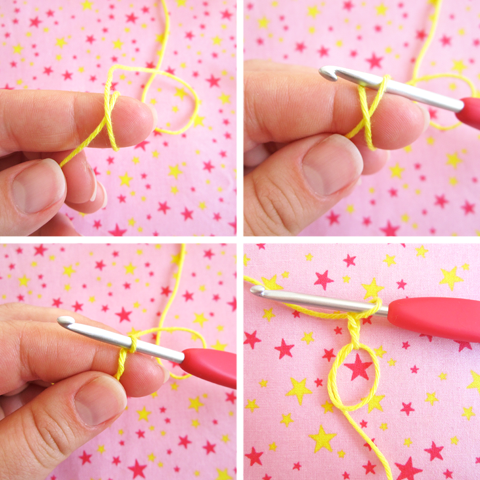
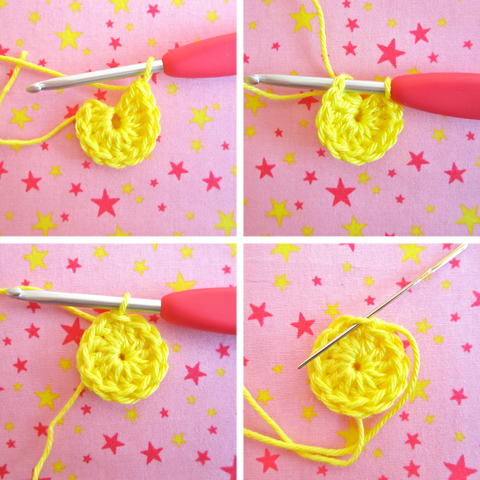
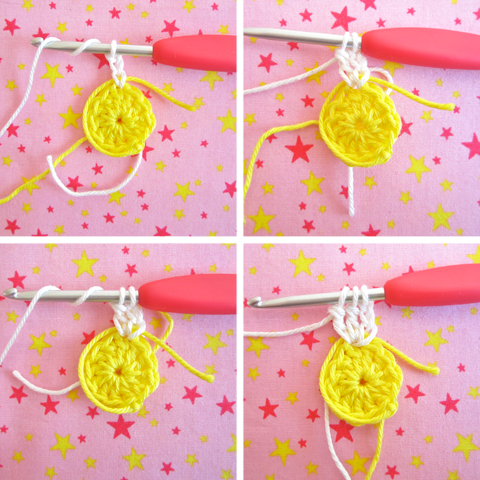

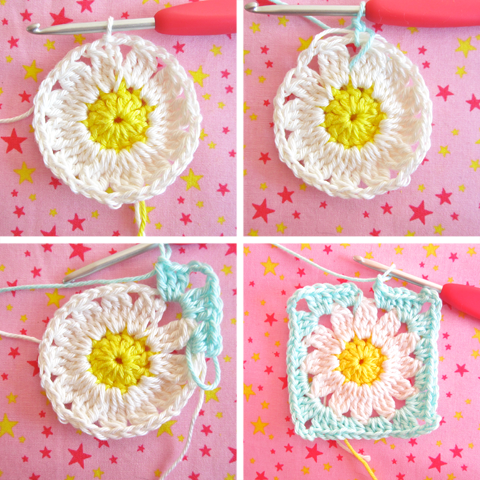
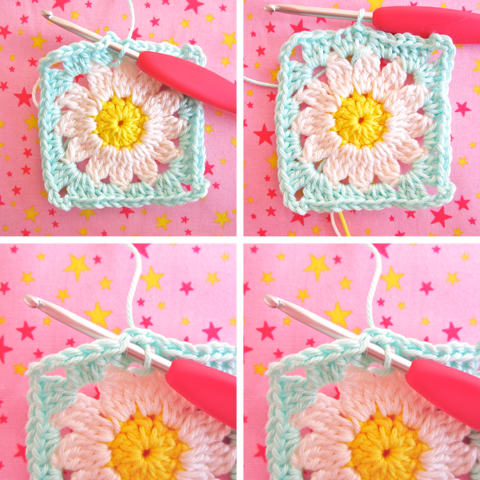

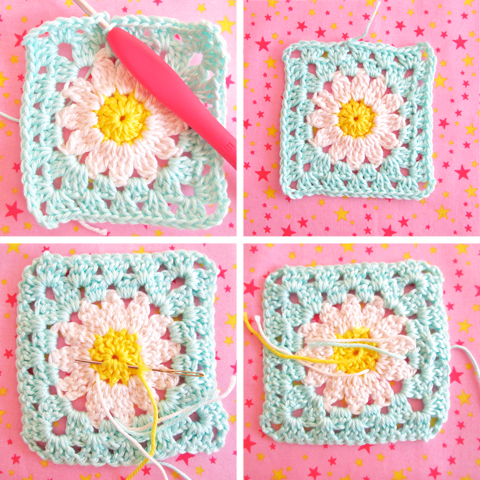
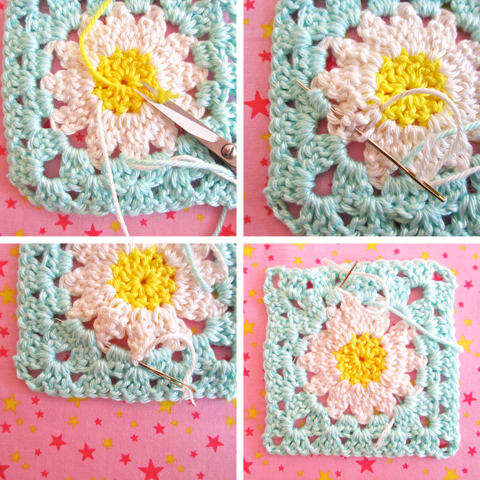
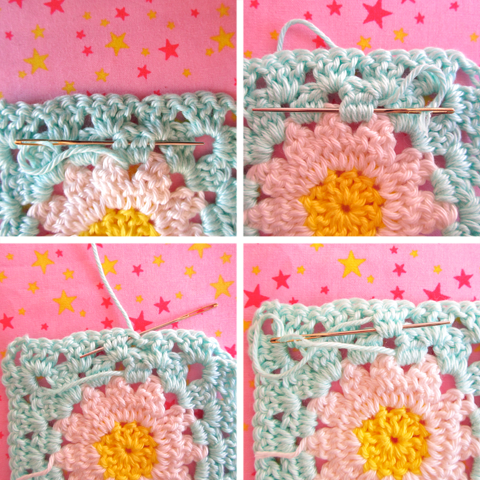
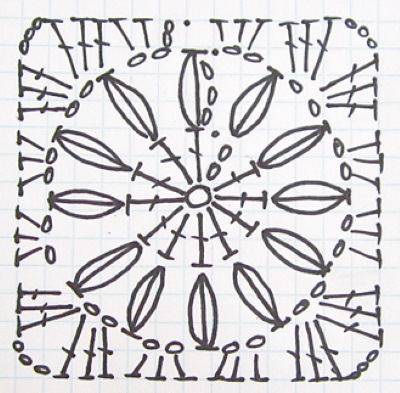
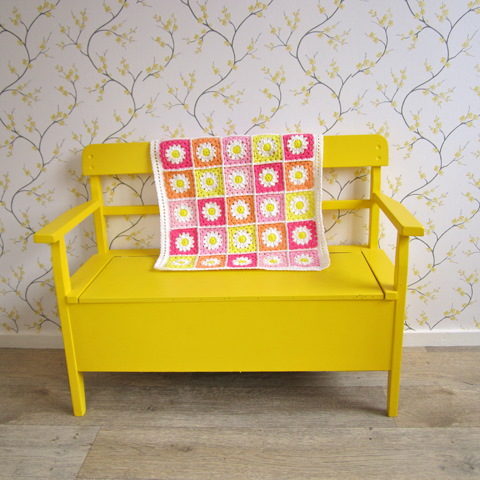
To knit another square, cast on 16 stitches and another 17 along the edge of the finished square. Knit in the same way. Knit a row of squares to the desired width and proceed to the 2nd and subsequent rows of the blanket.
Potholders and coasters
Knitting patterns for potholders or hot pads from leftover yarn is another idea for coziness and home decoration.
Round crochet potholders
Close the VP into a ring and collect 12 dc in it, continue knitting in a spiral, knitting 2 dc in each loop. Next, in turn, knit 2 dc over 2 dc, in other loops 1 dc. Having knitted a potholder of the required size, make a loop for hanging the potholder - knit a chain from air loops.
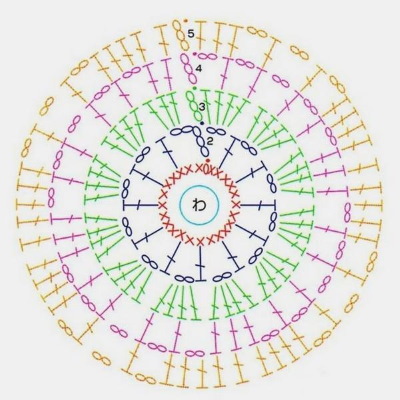
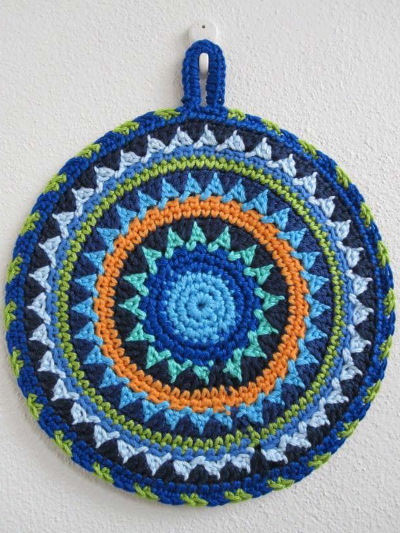
Example of binding for the edge of a potholder or a hot pad: *into the 2nd loop 2 dc, 1 VP, 2 dc; skip the loop of the bottom row - 1 sc*. Having bound the larger half of the product, you can count the loops, and if there are not enough, slightly change the arrangement of the double crochets. The loop for hanging potholders can be evenly bound with single crochets.
Knitting potholders
Attractive potholders can be obtained by combining threads of different shades, if you knit squares with any pattern or satin stitch. It is better to choose a color to match the kitchen.
Covers
The remains of knitting threads are used to make furniture covers and other items.
Stool cover
To crochet a stool cover, you will need:
- Knit several strips of 1 row of VP and 2 rows of sc according to the size of the stool.
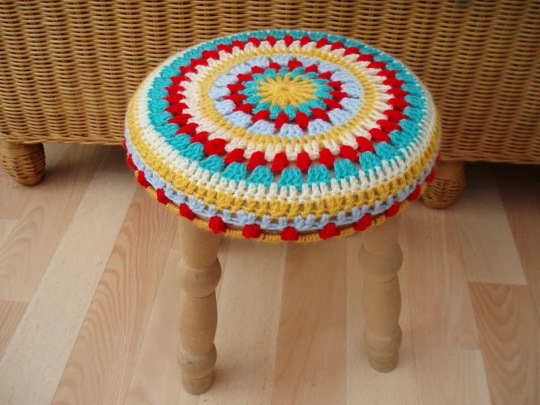
- Along the narrow side of the strip, connect with single crochet stitches into 2 groups of the same number of strips.
- Assemble the resulting parts into one product by interlacing.
Mobile phone case "Cat"
Crochet a chain of 20 VP. Rows 1–4: 19 sc, 1 PP, turn. Then knit in a circle with sc to the desired size. Ears: 1 dc, 3 dc/2 h in one loop, 1 dc/3 h in the next loop, 2–4 sc in an arc of dc/3 h.
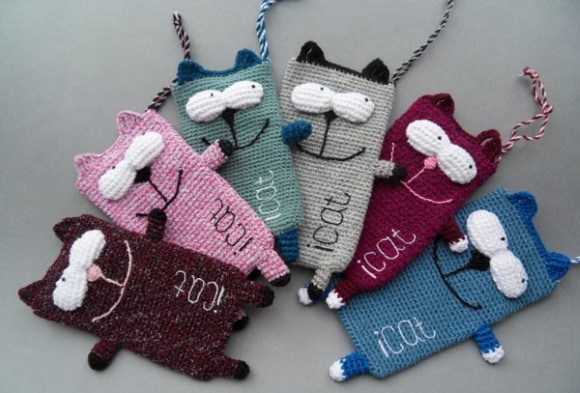
Paws: close a chain of 3 ch into a ring; knit 7 sc into the center of the ring; *sc, 2 sc in one loop*; knit in a circle sc. Eyes: knit a chain of 18 ch, knit sc, make increases on the sides (2 sc in one loop), then decrease again (make 1 sc from 2 sc).
Flower decorations
Knitting from yarn scraps, flower patterns allow you to create clothing decorations or soft jewelry: beads, necklaces, bracelets, and even earrings. By choosing the shades of threads, you can knit a bouquet of a variety of flowers.
For jewelry, it is better to use thinner yarn.
Crochet flower
Crochet flower step by step:
- 6 VP chains connect into a circle;
- make 3 PP and knit 24 dc;
- knit 2 dc into one loop, then 1 dc, alternating until the end of the row;
- knit a row similar to the previous one;
- make petals: *skip 2 VP, in the 3rd tie 11 dc/2 n, skip 2 VP and tie dc/n*, break the thread;
- from the front side, go to the 2nd row and knit all sc for the front loops;
- make the remaining petals in the same way as the previous ones, but instead of 11 dc/2 n, knit 9.
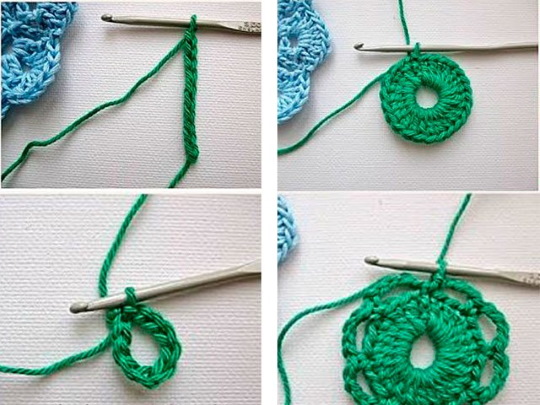
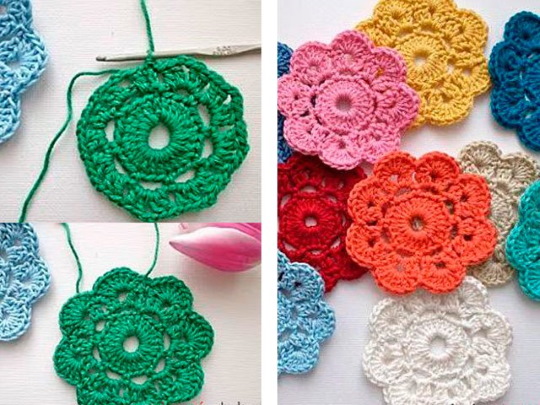
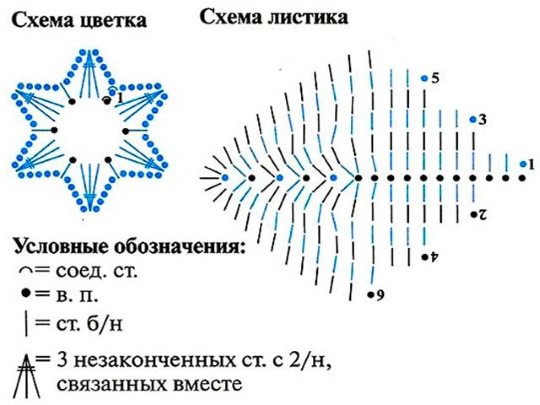
There are many options for crocheting flowers, but a flower knitted with knitting needles looks no less attractive.
Flower knitting needles
To knit a petal, you need to cast on 8 sts, remove the first one without knitting:
- In the 1st row all LP.
- In the 2nd - IP.
- In row 3: *LP, nak.*.
- 4th row: SP.
- 5th row: LP.
- Repeat, alternating, the pattern of rows 4 and 5 until the desired height (this will be the middle of the petal).
- Then knit 2 LP together, then all LP, knit the last 3 loops: 2 LP together, LP.
- In the next row: 2 IP together, then all IP, last 3 sts: 2 IP together, LP.
- Repeat the decrease until there are 3 sts left.




- Close the knitting according to the standard pattern.
- You need to make 6 petals and then fasten them together.
The center of the flower can be decorated with a bead.
Baskets
From the leftover yarn you can make a great basket, which will serve to store small items or become a souvenir and interior decoration. Baskets can be round, oval, square, with or without handles. It is better to do the work with a crochet hook.
Square basket for storing small items
The entire basket is crocheted with single crochet stitches, the bottom is square-shaped. The balls are joined into thick yarn, using hook No. 6.
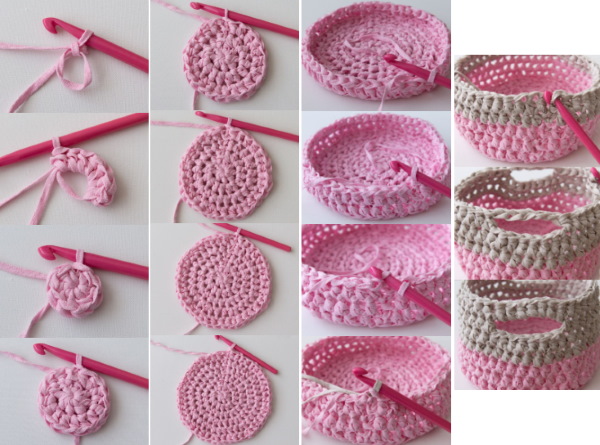
Step by step:
- Knit a ring of VP and sc, 2 PP and fill the ring with 8 sc. Finish the row (as well as all subsequent rows) with a slip stitch in the lifting chain stitch.
- A square is knitted. 2 PP, 3 sc in one loop – a corner is formed. Between the corners 1 sc.
- 2 PP, 1 sc, corner (3 sc in one loop). Between the corners, knit 3 sc on 3 sides. After the 4th corner, knit 1 sc and a connecting loop into the lifting chain stitch.
- 2 PP, 2 sc, corner, *5 sc, corner*, repeat 2 sc.
- 2 PP, 3 sc, corner, *7 sc, corner*, 3 sc.
- 2 PP, 4 sc, corner, *9 sc, corner*, 4 sc.
- 2 PP, 5 sc, corner, *11 sc, corner*, 5 sc.
- 2 PP, 6 sc, corner, *13 sc, corner*, 6 sc.
Depending on the thickness of the threads, you get a square with a side of 16 cm. Without increases or decreases, knit 1 row with single crochets, capturing the back wall of the base loop. Knit the next 2 rows, forming the walls of the basket. For them, you can use yarn of contrasting shades. You can tie the bottom and top of the basket with a contrasting thread.
Baskets of various shapes
If, making even increases, you tie a round bottom with single crochets, you will get a round basket. You will get handles if, when tying the top of the basket, you leave the same number of VP on both sides and tie the next row with SN.

To give the product a strict shape, metal and plastic parts are tied and connected: rings, triangles, squares or use wire as a base. This idea can be used for a basket, a panel or toys.
Panel
Knitting cross stitch patterns from leftover yarn results in a picture or panel that will decorate the interior or serve as a gift to family and friends.
Knitted picture
According to the pattern, the number of loops equal to the number of squares is cast on the knitting needles. The stocking stitch is knitted. When changing the color, the non-working thread is passed behind the fabric, from the inside. After completing the main work, the parts can be sewn with a stem stitch. Carefully steam the finished product from the inside and insert it into the frame.
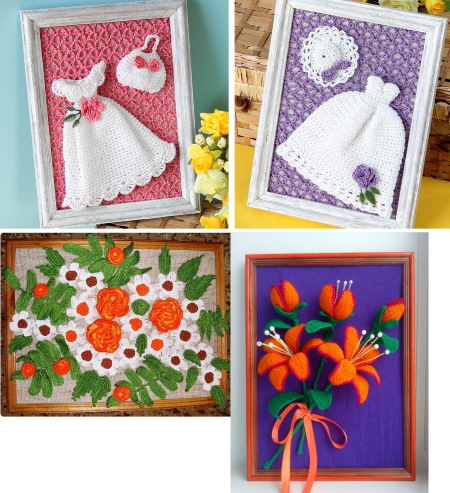
The picture will be more interesting if you add volumetric details, such as flowers and leaves. Beads, sequins and buttons are suitable for decoration.
Pillows
You can knit pillows from yarn scraps using different patterns, alternating patterns, textures and shades of threads. For example, knit one side with diamonds and the other with braids.
Round pillow with zigzag crochet pattern
Two fragments are knitted with a zigzag pattern, the parts are connected in a circle and then with each other. Knitting begins from the outer edge. The required number of air loops is collected with a crochet hook. According to the diagram, a strip is knitted with a wave pattern. In the front rows, dc are knitted, in the back rows - sc. The zigzag is obtained by adding and decreasing double crochets at equal intervals.
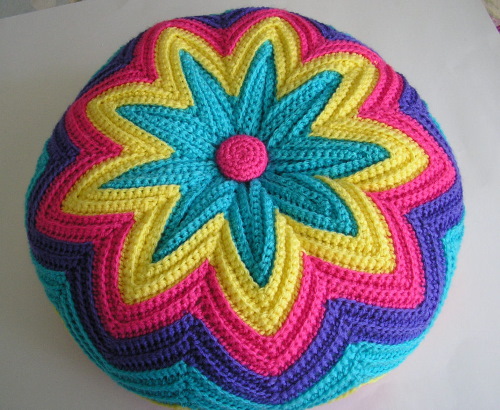
To widen or narrow the canvas, the number of columns in the gaps changes. The strip is made of the required width, alternating threads of different colors, and connected in a circle. The corners are sewn or crocheted, a large button is sewn in the center. There is no need to iron or fold the circle. The back of the pillow is made in the same way, and both sides are sewn.
Rectangular pillow knitted
It is more convenient to knit a pillow with knitting needles as a single piece, joining the 3 sides at the end of the work. The pattern can be any, for example, pearl. It is also called a tangle or rice pattern.
Knitting:
- 1 row: *1 LP, 1 IP*.
- 2 rows: according to the pattern.
- 3 rows: *1 IP, 1 LP*.
Then the pattern is repeated in a circle, starting from row 1.
Toys
Leftover yarn can be used to create original Christmas tree-shaped toys.
Christmas trees
The dimensions of the miniature Christmas trees are: width 9 cm and height 15 cm. Yarn of any texture and color will do, you will need knitting needles No. 4.5 and beads, stars, beads and other decorations.

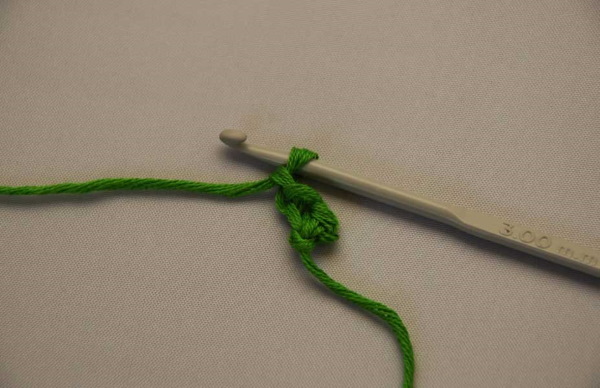
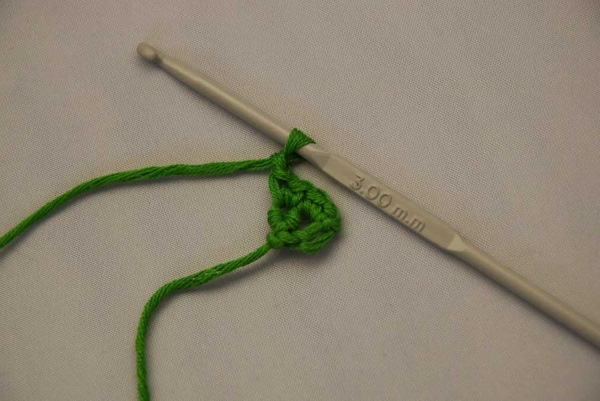
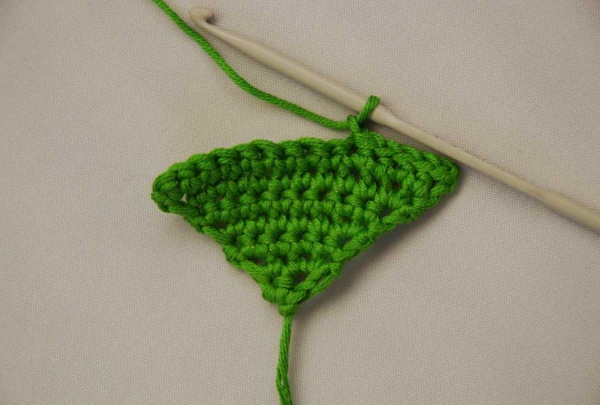
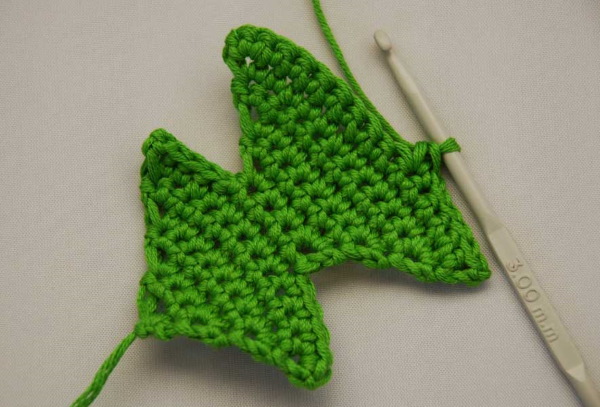
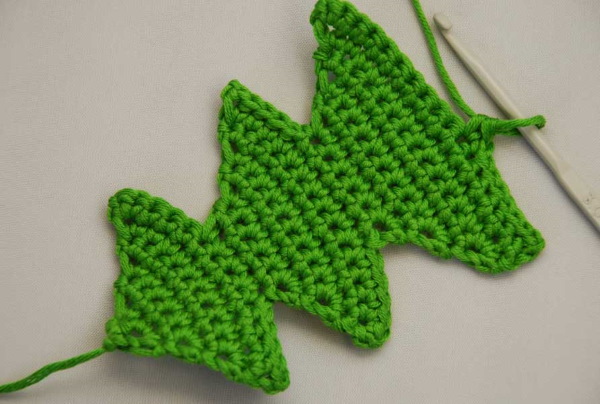
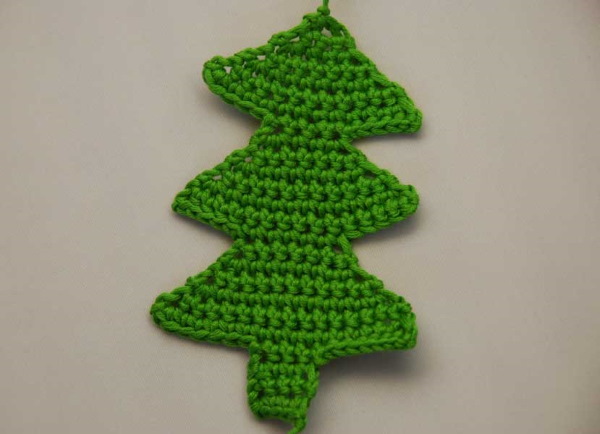

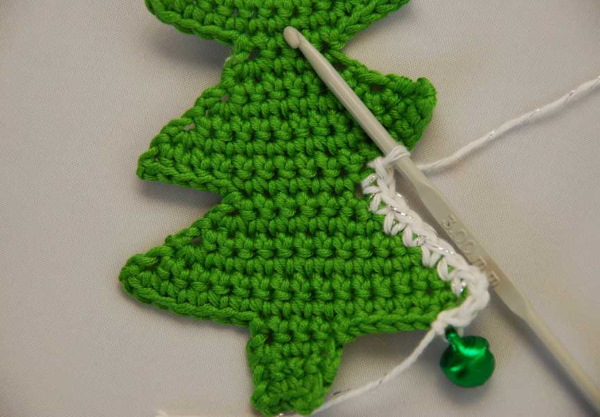
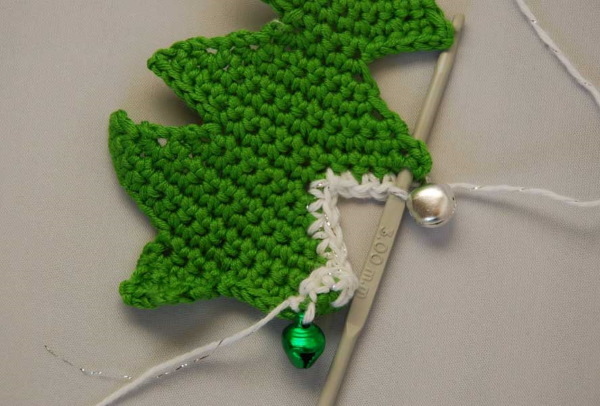
Knitting:
- Knit 5 rows with 4 LPs.
- In the next two rows add 7 sts.
- Knit in the 1st row LP, in the 2nd and all even rows – IP.
- In the 3rd row: 1 LP, knit a draw through (slip 1 st as if to knit, 1 LP, pull it through the slipped st). After that, you need to knit all the LPs, the last 3 - 2 LPs together, 1 LP.
- Repeat the knitting pattern in rows 1-4 until there are 4 sts on the needles.
- After a row of purl stitches, knit a yarn over and 2 together LP.
- In the next row - 2 together IP.
Knit two identical parts, connect with a crochet hook or sew and decorate with beads. Make a loop from the remaining thread, for example, by knitting a chain with air loops.
Sweaters and other clothes
The leftover threads can be used to make a striped scarf or hat, socks or leg warmers and other creative clothes. For example, a summer sweater, for knitting which a wavy pattern is suitable. Every few rows you can use threads of different colors.
Wavy knitting pattern
The number of loops must be in the following multiple: 16 + 1 + 2 edge loops:
- Row 1: at the beginning, remove 1 kr.p., rapport *LP, nak., LP, nak., LP, nak., 2 yarn overs, remove 1 st as if to knit, knit 2 LP together and pull it through the removed loop, 2 LP together, 2 together LP, nak., LP, nak., LP, nak.* repeat, 1 LP.
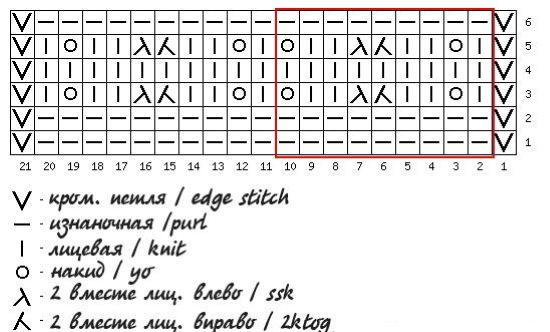
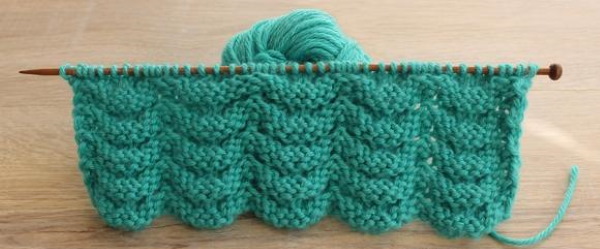
- Row 3: knit the entire front loop.
- From the inside of the product, all loops and yarn overs must be knitted as is.
- The broaches are knitted as follows: remove 1 st as if it were a front stitch, knit 1 LP, pull it through the removed st.
Motley circles
If you crochet several circles of different sizes and colors from the leftover yarn and then connect them according to the pattern, you will get an original pullover or vest.
For the circle: make a chain of 5 ch and close into a ring. Knit 3 lifting ch at the beginning of the row and a slip stitch at the end. 1st row: 15 dc; 2nd – 5th row: double the number of dc in the previous row.
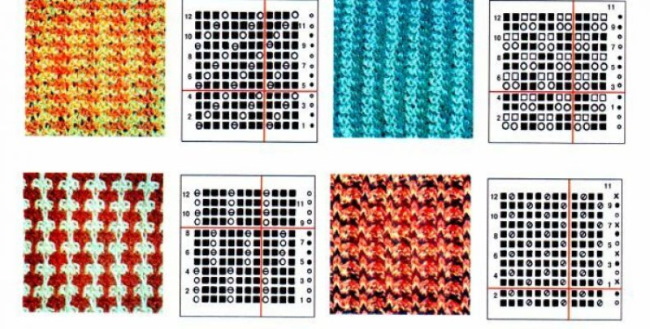
Place large circles on a life-size paper pattern and fill the space between them with small ones. Sew the circles together where they touch. In addition to regular clothing, you can knit doll clothes from leftover yarn.
Knitting according to the pattern of any product from yarn remnants is sometimes much more interesting in its design solutions and beauty than traditional knitting with yarn of one color and texture. You only need desire and a little imagination.
Article formatting:Natalie Podolskaya
Video about knitting from leftover yarn
Knitting from leftover yarn with crochet hook and knitting needles - basic rules:
